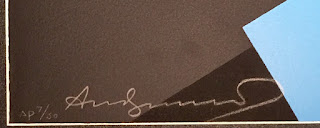Proposal for a Civic Monument in the Form of Two Windows, 1982; Lithograph on Arches Cover paper; Initialed CO and dated '82 in pencil bottom center and numbered 54/75 in pencil lower left; Published by Anthology Film Archives, NY; Catalog Raisonne: Axsom 179; Size - Sheet 28" x 40", Frame 33" x 45"; Framed with a linen liner, black wood frame, and UV plexiglass.
To purchase this work or to visit the Art Gallery, CLICK HERE
To purchase this work or to visit the Art Gallery, CLICK HERE
Claes Oldenburg is an American sculptor living and working in New York and he is best known for his public art installations, which usually feature either very large replicas or soft sculpture versions of everyday objects. Many of the works were made in collaboration with his wife of 32 years, Coosje van Bruggen; who passed away in 2009.
Close up of the image of the two windows and the surrounding landscape.
Oldenburg began working with with the idea of soft sculpture in 1957, when he completed a free-hanging piece made from a woman's stocking stuffed with newspaper (titled later as "Sausage"). In 1959, he began to make figures, signs, and objects out of papier-mâché, sacking, and other rough materials. This was followed in 1961 by objects created out of plaster and enamel, drawing inspiration from food and cheap clothing. In the 1960s he was very involved with the "Happenings" movement and his own productions were entitled "Ray Gun Theater." His artistic collaboration involved other members of the art scene and included: Lucas Samaras, Tom Wesselman, Carolee Schneemann, Oyvind Fahlstrom, Richard Artschwager, art dealer Annina Nosei, art critic Barbara Rose, and screenwriter Rudy Wurlitzer. In December 1961, he rented a storefront on Manhattan's Lower East Side to house "The Store;" a month-long installation he had first presented at the Martha Jackson Gallery in New York, stocked with rough sculptures of consumer goods.
Close up of the edition number, 54/75.
Close up of the initials CO (Claes Oldenburg) and the date '82
Oldenburg moved to Los Angeles, California in 1963. By 1965 he had turned his attention to drawings and projects for imagined outdoor monuments. This work, "Proposal for a Civic Monument in the Form of Two Windows" from 1982 is continuing his work that was begun back in 1965. By this time Oldenburg is at his height in his draftsman abilities, and his skill can be seen in this large format lithograph. The size of the windows is extraordinary, given the scale derived from the trees in the background and the people in the foreground. Although Oldenburg is most noted for his outdoor installations, this work showcases his immense artistic skill working in a 2-D medium.
Framed "Proposal for a Civic Monument in the Form of Two Windows," 1982 by Claes Oldenburg.













